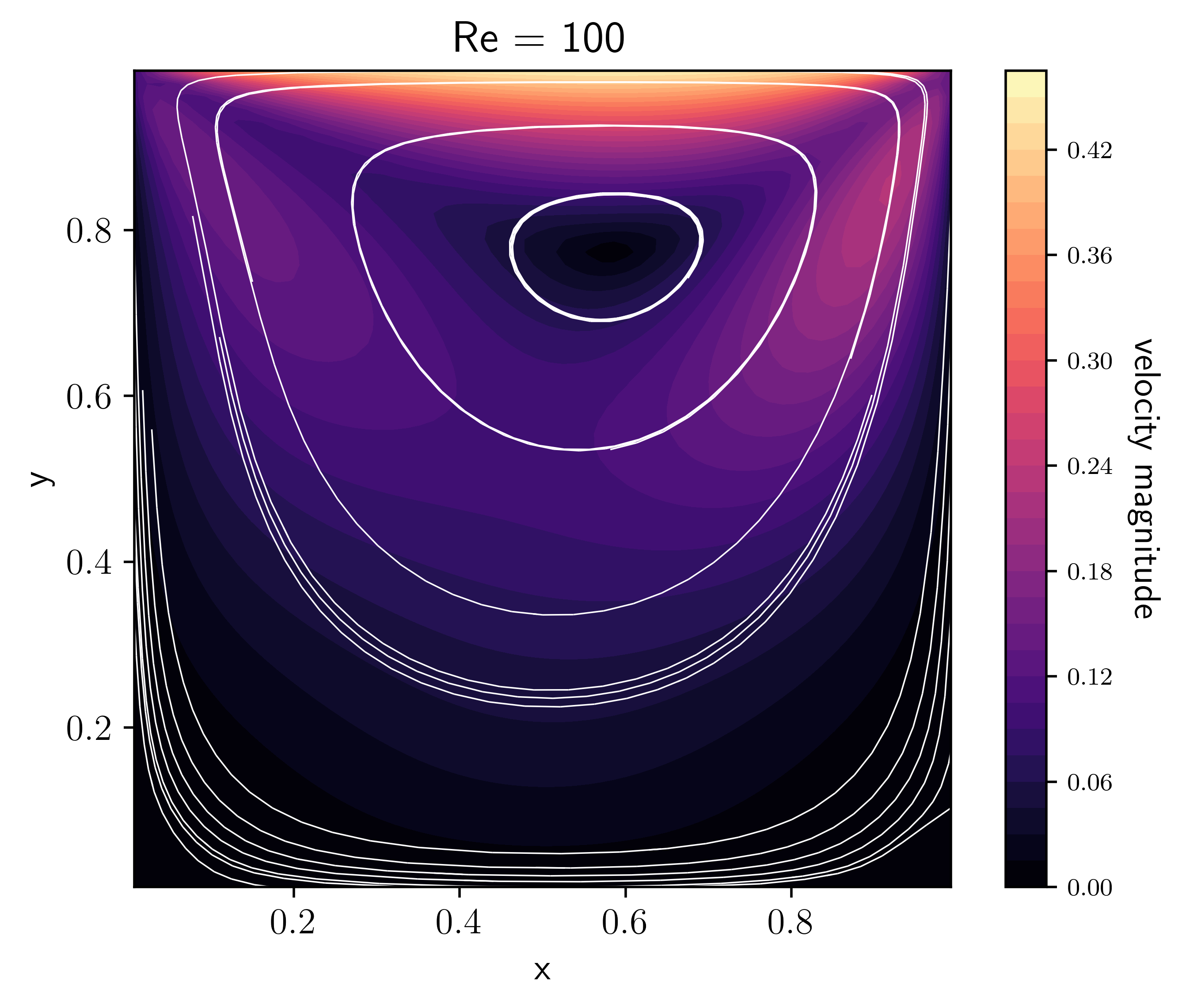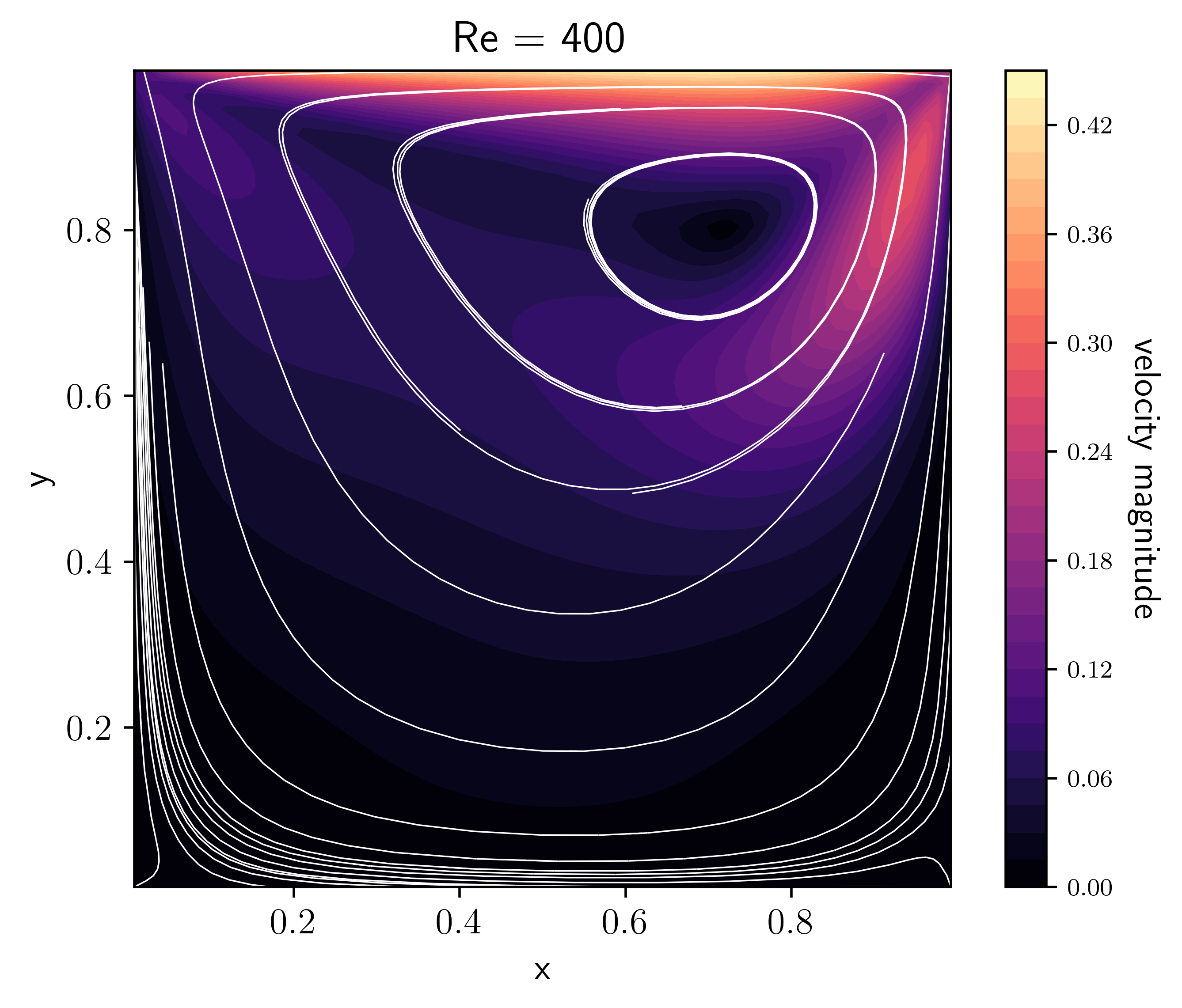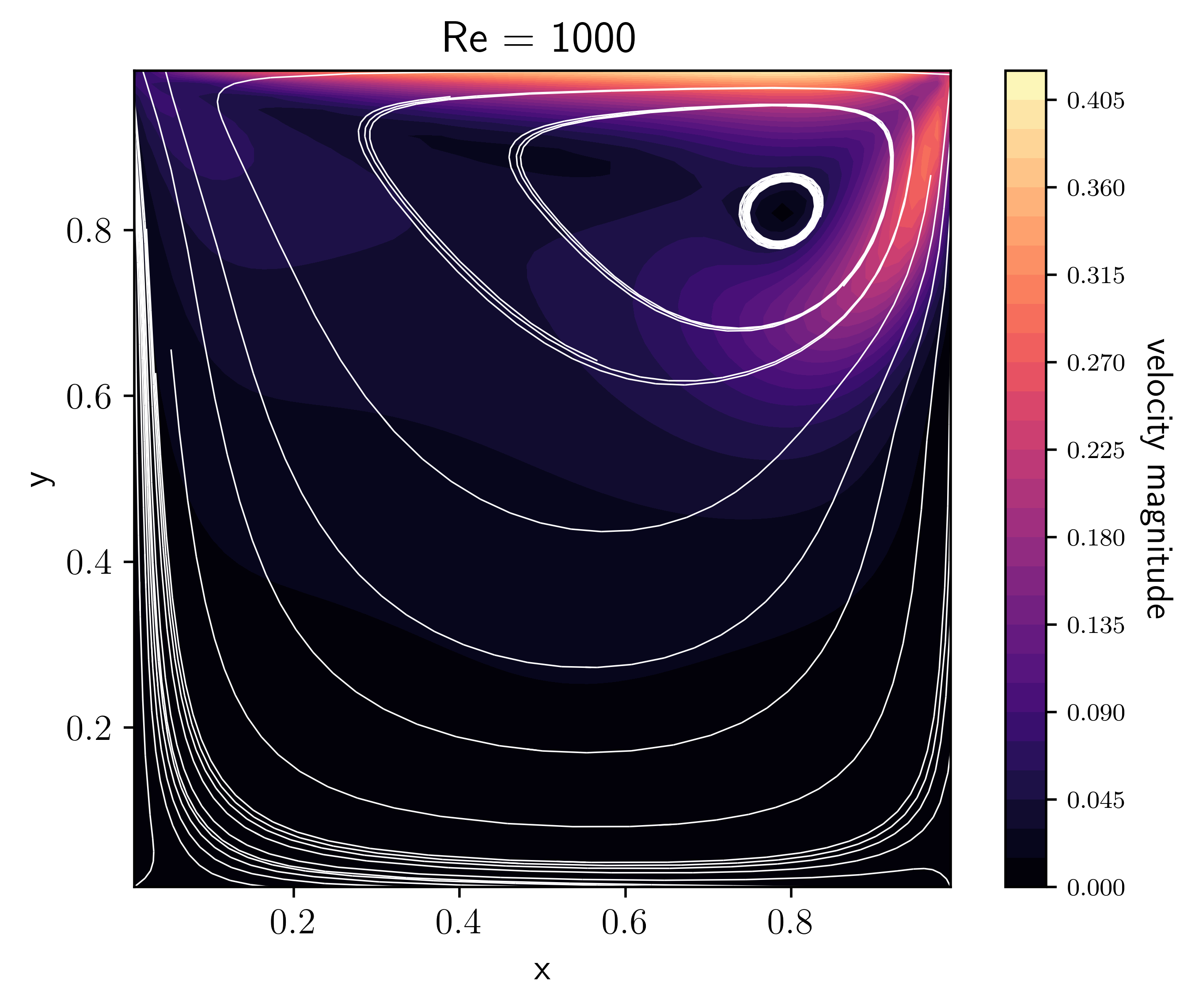Incompressible hydrodynamics#
pyro has two different incompressible solvers: incompressible is
inviscid and incompressible_viscous has viscosity.
incompressible solver#
pyro’s incompressible solver solves:
The algorithm combines the Godunov/advection features used in the advection and compressible solver together with multigrid to enforce the divergence constraint on the velocities.
Here we implement a cell-centered approximate projection method for solving the incompressible equations. At the moment, only periodic BCs are supported.
The main parameters that affect this solver are:
section:
[driver]option
value
description
cfl0.8section:
[incompressible]option
value
description
limiter2limiter (0 = none, 1 = 2nd order, 2 = 4th order)
proj_type2what are we projecting? 1 includes -Gp term in U*
section:
[particles]option
value
description
do_particles0particle_generatorgrid
supported problems#
converge#
Initialize a smooth incompressible convergence test. Here, the velocities are initialized as
and the exact solution at some later time t is then
The numerical solution can be compared to the exact solution to measure the convergence rate of the algorithm. These initial conditions come from Minion 1996.
shear#
Initialize the doubly periodic shear layer (see, for example, Martin and Colella, 2000, JCP, 163, 271). This is run in a unit square domain, with periodic boundary conditions on all sides. Here, the initial velocity is:
parameters:
name |
default |
|---|---|
|
42.0 |
|
0.05 |
Examples#
shear#
The shear problem initializes a shear layer in a domain with doubly-periodic boundaries and looks at the development of two vortices as the shear layer rolls up. This problem was explored in a number of papers, for example, [BellColellaGlaz89] and [MartinColella00]. This is run as:
pyro_sim.py incompressible shear inputs.shear
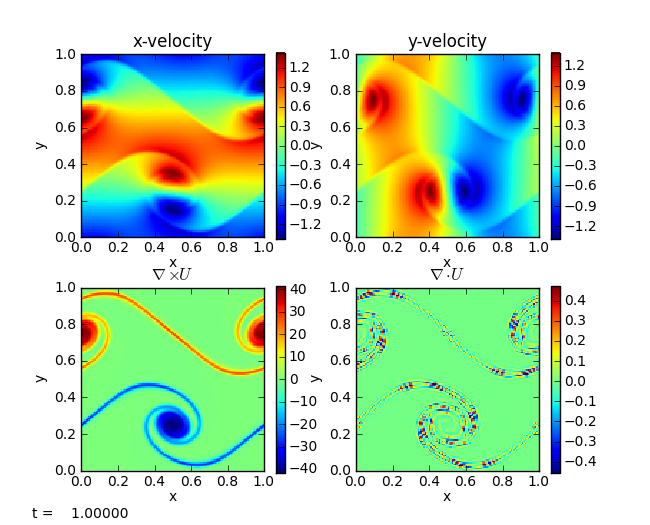
The vorticity panel (lower left) is what is usually shown in papers. Note that the velocity divergence is not zero—this is because we are using an approximate projection.
convergence#
The convergence test initializes a simple velocity field on a periodic
unit square with known analytic solution. By evolving at a variety of
resolutions and comparing to the analytic solution, we can measure the
convergence rate of the algorithm. The particular set of initial
conditions is from [Minion96]. Limiting can be disabled by
adding incompressible.limiter=0 to the run command. The basic set of
tests shown below are run as:
pyro_sim.py incompressible converge inputs.converge.32 vis.dovis=0
pyro_sim.py incompressible converge inputs.converge.64 vis.dovis=0
pyro_sim.py incompressible converge inputs.converge.128 vis.dovis=0
The error is measured by comparing with the analytic solution using
the routine incomp_converge_error.py in analysis/. To generate
the plot below, run
python incompressible/tests/convergence_errors.py convergence_errors.txt
or convergence_errors_no_limiter.txt after running with that option. Then:
python incompressible/tests/convergence_plot.py

The dashed line is second order convergence. We see almost second order behavior with the limiters enabled and slightly better than second order with no limiting.
incompressible_viscous solver#
pyro’s incompressible viscous solver solves:
This is based on the incompressible solver, but modifies the
velocity update step to take viscosity into account, by solving two
parabolic equations (one for each velocity component) using multigrid.
The main parameters that affect this solver are:
section:
[driver]option
value
description
cfl0.8section:
[incompressible]option
value
description
limiter2limiter (0 = none, 1 = 2nd order, 2 = 4th order)
proj_type2what are we projecting? 1 includes -Gp term in U*
section:
[incompressible_viscous]option
value
description
viscosity0.1kinematic viscosity of the fluid (units L^2/T)
section:
[particles]option
value
description
do_particles0particle_generatorgrid
supported problems#
cavity#
Initialize the lid-driven cavity problem. Run on a unit square with the top wall moving to the right with unit velocity, driving the flow. The other three walls are no-slip boundary conditions. The initial velocity of the fluid is zero.
Since the length and velocity scales are both 1, the Reynolds number is 1/viscosity.
References: https://doi.org/10.1007/978-3-319-91494-7_8 https://www.fluid.tuwien.ac.at/HendrikKuhlmann?action=AttachFile&do=get&target=LidDrivenCavity.pdf
converge#
Initialize a smooth incompressible+viscous convergence test. Here, the velocities are initialized as
and the exact solution at some later time t, for some viscosity nu, is
The numerical solution can be compared to the exact solution to measure the convergence rate of the algorithm.
shear#
Initialize the doubly periodic shear layer (see, for example, Martin and Colella, 2000, JCP, 163, 271). This is run in a unit square domain, with periodic boundary conditions on all sides. Here, the initial velocity is:
parameters:
name |
default |
|---|---|
|
42.0 |
|
0.05 |
Examples#
shear#
The same shear problem as in incompressible solver, here with viscosity added.
pyro_sim.py incompressible_viscous shear inputs.shear
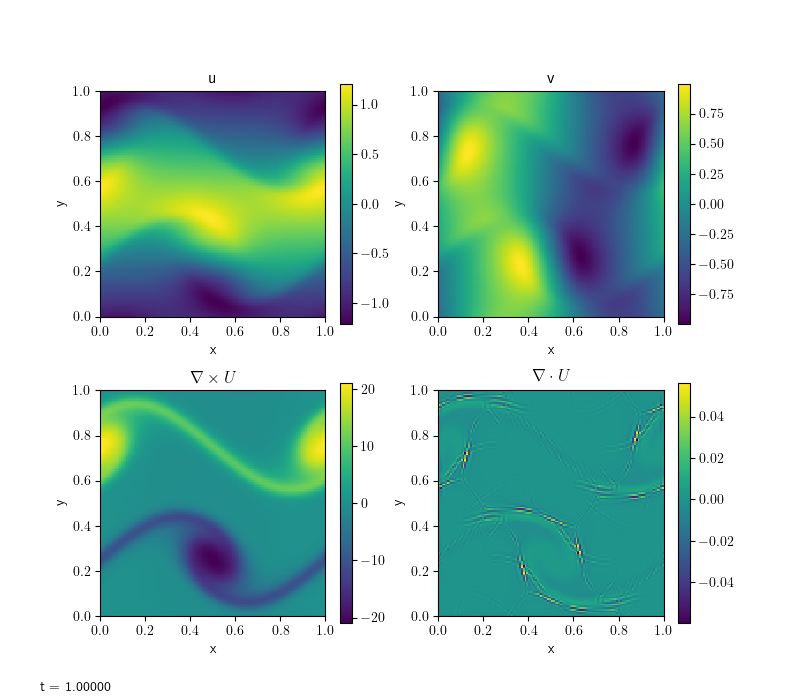
Compare this with the inviscid result. Notice how the velocities have diffused in all directions.
cavity#
The lid-driven cavity is a well-known benchmark problem for hydro codes (see e.g. Ghia et al. [GhiaGhiaShin82], Kuhlmann and Romanò [KRomano19]). In a unit square box with initially static fluid, motion is initiated by a “lid” at the top boundary, moving to the right with unit velocity. The basic command is:
pyro_sim.py incompressible_viscous cavity inputs.cavity
It is interesting to observe what happens when varying the viscosity, or, equivalently the Reynolds number (in this case \(\rm{Re}=1/\nu\) since the characteristic length and velocity scales are 1 by default).
These plots were made by allowing the code to run for longer and approach a
steady-state with the option driver.max_steps=1000, then running
(e.g. for the Re=100 case):
python incompressible_viscous/problems/plot_cavity.py cavity_n64_Re100_0406.h5 -Re 100 -o cavity_Re100.png
convergence#
This is the same test as in the incompressible solver. With viscosity,
an exponential term is added to the solution. Limiting can again be
disabled by adding incompressible.limiter=0 to the run command.
The basic set of tests shown below are run as:
pyro_sim.py incompressible_viscous converge inputs.converge.32 vis.dovis=0
pyro_sim.py incompressible_viscous converge inputs.converge.64 vis.dovis=0
pyro_sim.py incompressible_viscous converge inputs.converge.128 vis.dovis=0
The error is measured by comparing with the analytic solution using
the routine incomp_viscous_converge_error.py in analysis/. To
generate the plot below, run
python incompressible_viscous/tests/convergence_errors.py convergence_errors.txt
or convergence_errors_no_limiter.txt after running with that option. Then:
python incompressible_viscous/tests/convergence_plot.py
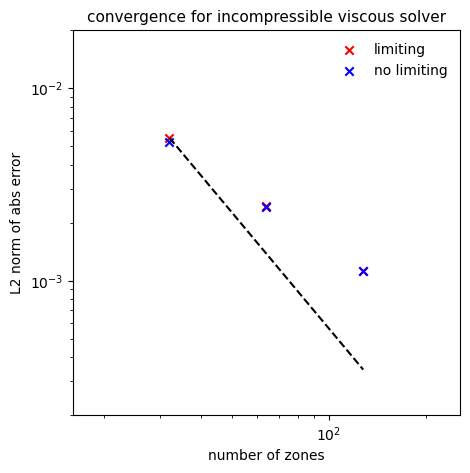
The solver is converging but below second-order, unlike the inviscid case. Limiting does not seem to make a difference here.
Exercises#
Explorations#
Disable the MAC projection and run the converge problem—is the method still 2nd order?
Disable all projections—does the solution still even try to preserve \(\nabla \cdot U = 0\)?
Experiment with what is projected. Try projecting \(U_t\) to see if that makes a difference.
In the lid-driven cavity problem, when does the solution reach a steady-state?
[GhiaGhiaShin82] give benchmark velocities at different Reynolds number for the lid-driven cavity problem (see their Table I). Do we agree with their results?
Extensions#
Switch the final projection from a cell-centered approximate projection to a nodal projection. This will require writing a new multigrid solver that operates on nodal data.
Switch to a variable density system. This will require adding a mass continuity equation that is advected and switching the projections to a variable-coefficient form (since ρ now enters).

